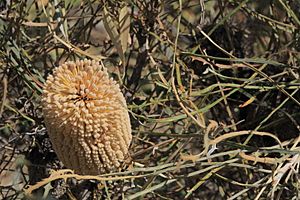Banksia lullfitzii facts for kids
Quick facts for kids Banksia lullfitzii |
|
|---|---|
 |
|
| Banksia lullfitzii at Hollywood Reserve, Perth | |
| Conservation status | |
| Scientific classification | |
| Genus: |
Banksia
|
| Species: |
lullfitzii
|
Banksia lullfitzii is a special type of shrub found only in the south-west part of Western Australia. It has long, narrow leaves with sharp teeth along the edges. Its flowers are a beautiful golden-orange to orange-brown color. After flowering, it produces up to thirty seed pods, called follicles, in each flower head.
Contents
What Does Banksia lullfitzii Look Like?
Banksia lullfitzii is a shrub that often spreads out. It usually grows about 0.8 to 2 meters (2.6 to 6.5 feet) tall. This plant has a special woody base called a lignotuber. This helps it regrow after things like bushfires.
Its leaves are long and narrow, like a line. They are about 200 to 450 millimeters (8 to 18 inches) long. The leaves are also 8 to 18 millimeters (0.3 to 0.7 inches) wide. Each leaf sits on a small stalk called a petiole, which is 10 to 30 millimeters (0.4 to 1.2 inches) long. The edges of the leaves have sharp, widely-spaced teeth.
The flowers grow in an oval or cylinder shape. When they open, these flower heads are 40 to 130 millimeters (1.6 to 5.1 inches) long. They are also 80 to 100 millimeters (3.1 to 3.9 inches) wide. The flowers themselves are golden-orange to orange-brown. Each flower has a part called the perianth, which is 34 to 49 millimeters (1.3 to 1.9 inches) long. It also has a curved pistil, which is 33 to 48 millimeters (1.3 to 1.9 inches) long.
Banksia lullfitzii usually flowers from March to May. After flowering, up to thirty seed pods, or follicles, grow in each head. These pods are partly hidden by the old flower parts. The follicles are shaped like an ellipse. They are 15 to 25 millimeters (0.6 to 1 inch) long. They are also 8 to 12 millimeters (0.3 to 0.5 inches) high and 8 to 10 millimeters (0.3 to 0.4 inches) wide.
How Banksia lullfitzii Got Its Name
The plant Banksia lullfitzii was first described by a botanist named Charles Gardner. He wrote about it in 1966. Gardner named this plant after a nurseryman named Fred Lullfitz. The description was published in a science journal called The Western Australian Naturalist. Gardner found the first plant specimen near Southern Cross.
Later, in 1981, another scientist named Alex George studied the plant. He placed B. lullfitzii into a group called the Cyrtostylis series. Scientists often group plants together based on their features. This helps them understand how different plants are related.
Where Banksia lullfitzii Lives
Banksia lullfitzii is found in only a few places. These scattered groups of plants grow north of Esperance. They can be found as far as Koolyanobbing. These plants grow in deep yellow sand. They are often found in areas with heath or mallee-heath plants.
Even though not many groups of this plant are known, it is not thought to be in danger. This area is hard to reach and has not been fully explored. So, it's likely that there are more Banksia lullfitzii plants out there. Also, many known groups grow in special nature reserves. These include the Boorabbin National Park. The area also gets very little rain. This means the land is not likely to be cleared for farming.
Is Banksia lullfitzii Protected?
The Government of Western Australia's Department of Parks and Wildlife has given this banksia a special status. It is classified as "Priority Three". This means that scientists don't know much about it. It is only found in a few places. However, it is not in immediate danger of disappearing.
Growing Banksia lullfitzii
If you want to grow this plant from seeds, it's quite easy. The seeds do not need any special treatment. They usually start to germinate (sprout) in about 26 days.


